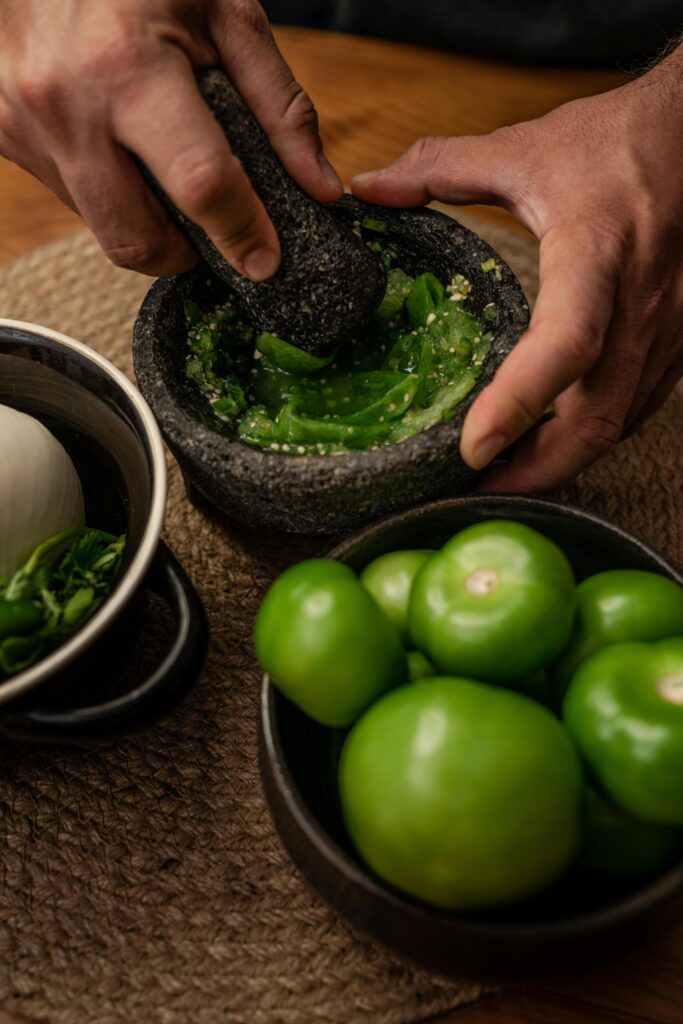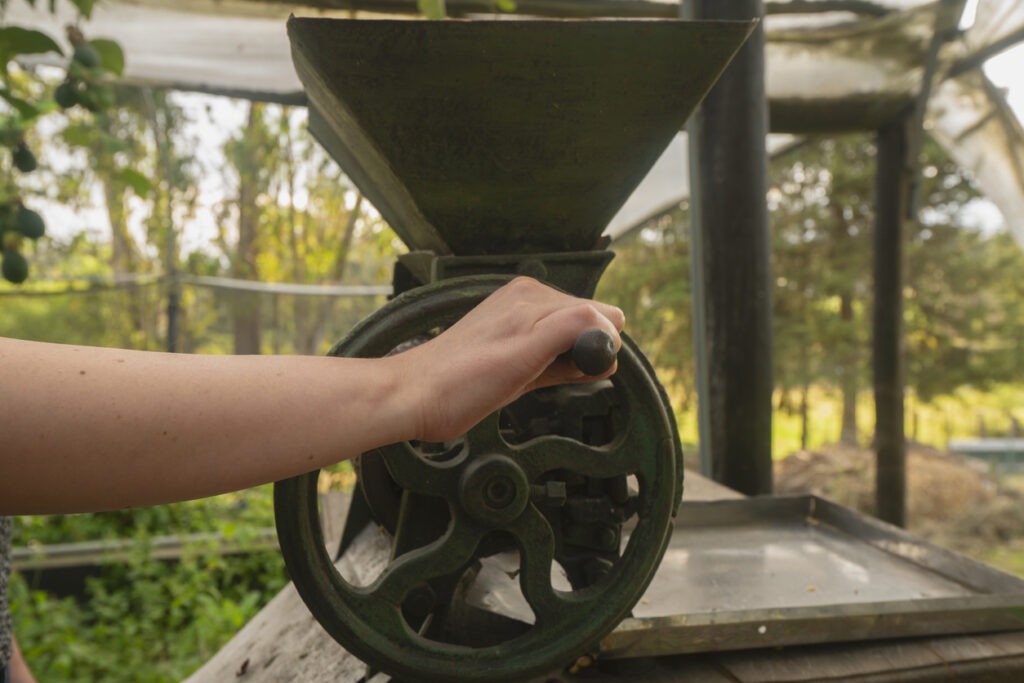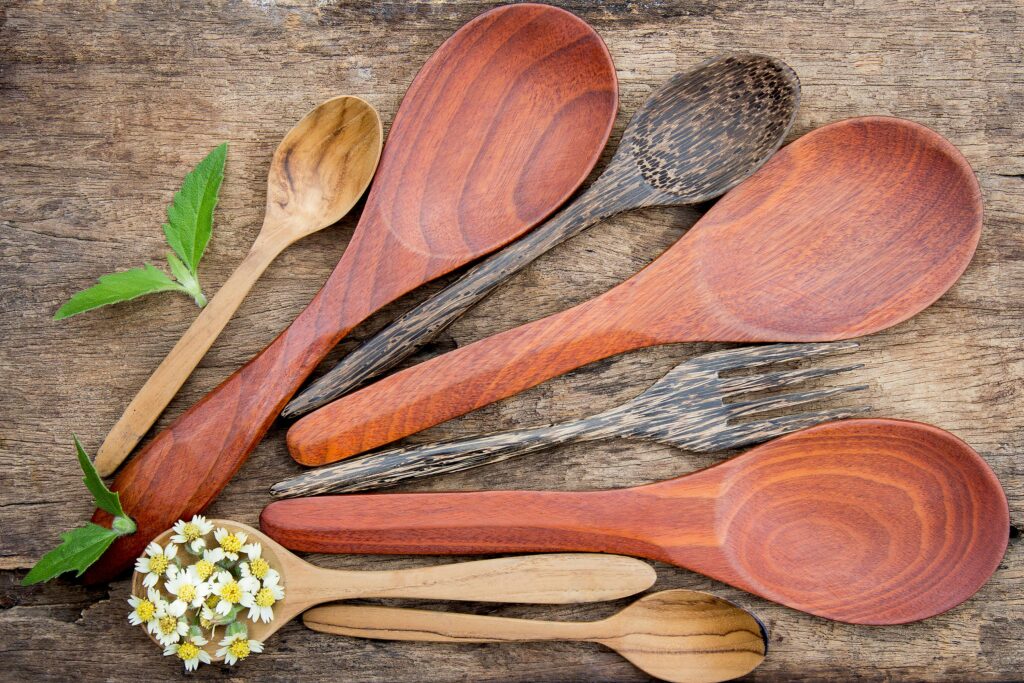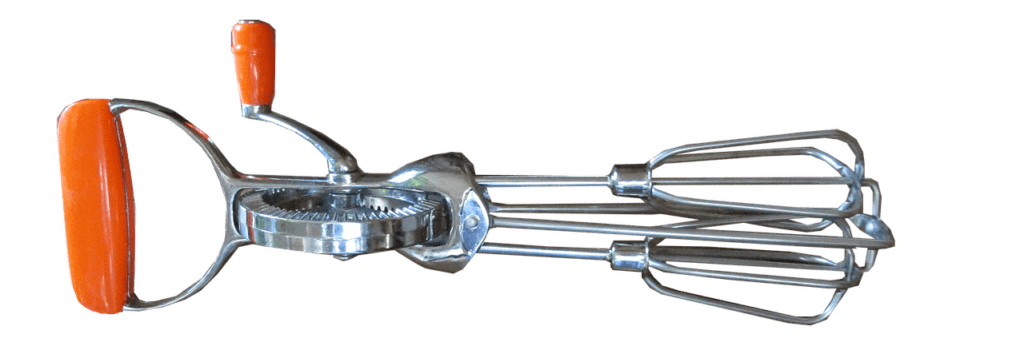You might think that before blenders, preparing foods like smooth soups and purees was nearly impossible, but that’s far from the truth. Our ancestors relied on a variety of manual methods, from the mortar and pestle grinding spices to the labor-intensive use of grinding stones. These tools didn’t just blend ingredients; they were a testament to human ingenuity and a deep connection with food preparation.
Each method, whether using a wooden spoon or a hand-cranked food mill, has its own story, a rich history that laid the foundation for the modern appliances we take for granted today. Let’s explore these ancient techniques and appreciate the evolution of culinary tools.
Mortar and Pestle: Timeless Technique
Long before modern blenders simplified kitchen tasks, the mortar and pestle stood as the go-to tools for grinding food into pastes, powders, and blends. You mightn’t realize it, but these age-old instruments were once central to food preparation, requiring not just skill but also a fair amount of physical effort and time. The act of grinding with a mortar and pestle isn’t just about pulverizing ingredients; it’s an art form that dates back to when wood and mud were the primary materials used for these tools.
Using a mortar and pestle, you’d crush herbs, spices, and grains, embracing a method that has remained largely unchanged over centuries. This timeless technique ensured that flavors were fully extracted and textures were precisely achieved, something that modern appliances strive to replicate. The tactile process of grinding with these tools connected you to the very essence of cooking, grounding you in the tradition of culinary craftsmanship.
Before the advent of electric blenders, having a mortar and pestle in your kitchen wasn’t just useful, it was essential for creating the base of many dishes, demonstrating the enduring importance of this method in food preparation.
Hand-Cranked Food Mills
Before electric blenders simplified food processing, you might’ve turned to hand-cranked food mills for your culinary tasks. These early kitchen gadgets required you to manually rotate a crank, engaging directly with the process of transforming ingredients.
They allowed for a precise control over texture, from smooth purees to coarser consistencies, embodying manual processing techniques of the past.
Early Kitchen Gadgets
Hand-cranked food mills once stood as essential tools in kitchens, enabling cooks to grind and mash ingredients without the need for modern blenders. These manual tools, operated through a crank mechanism, demanded physical effort but excelled in versatility. You’d find them crucial for food preparation, achieving textures from smooth purees to chunky mashes.
| Feature | Benefit |
|---|---|
| Crank mechanism | Enables manual control over texture |
| Physical effort | No need for electricity; eco-friendly |
| Versatility | Suitable for fruits, vegetables, and meats |
| Texture variety | From fine purees to coarse mashes |
Before the advent of electric blenders, hand-cranked food mills were indispensable in making baby food, sauces, and soups, highlighting their essential role in early kitchen gadgetry.
Manual Processing Techniques
Building on the foundation of early kitchen gadgets, we now explore how manual processing techniques, specifically through the use of hand-cranked food mills, revolutionized food preparation.
These mills, essential for grinding, mashing, and pureeing, demanded a physical effort from you but rewarded with precise control over your culinary creations’ texture. Whether you were tackling fruits, vegetables, or meats, these versatile tools allowed you to achieve the desired consistency, a testament to their indispensability in kitchens before blenders took over.
Hand-cranked food mills were more than just gadgets; they were your partners in crafting everything from smooth sauces to perfect purees, proving that manual processing wasn’t just a task but an art form in creating dishes that delighted the senses.
The Sturdy Wooden Spoon
The sturdy wooden spoon, a chef’s reliable ally, was key in manually blending ingredients before the advent of electric blenders. Crafted from durable wood and sporting a long handle, it allowed for easy maneuvering during food preparation. You’d find it indispensable for mixing, stirring, and blending a variety of ingredients in pots, bowls, and pans. This tool provided a hands-on blending method that was both simple and effective.
Wooden spoons were central to combining ingredients, ensuring that cooks could blend batters, sauces, and other mixtures to achieve the perfect texture. Its design wasn’t only practical for mixing but also for ensuring that food could be prepared with precision and care. Before the convenience of blenders, you’d rely heavily on the wooden spoon to control the blending process, making it a fundamental utensil in kitchens.
This manual blending tool allowed for a tactile feel of the food’s consistency, giving you direct control over the outcome of your culinary creations. The wooden spoon was, therefore, more than just a utensil; it was a crucial component in the art of food preparation, embodying the hands-on approach to cooking that defined generations.
Sieve: The Old-School Processor
Before the advent of blenders, you’d likely have used a sieve, a tool with a rich history in food processing. These old-school processors required you to push soft food through their mesh to break it down.
Let’s explore how sieves functioned and their historical uses in kitchens of the past.
Sieve Functionality Explained
Long before modern kitchen gadgets, sieves served as the go-to tool for processing foods, featuring wooden frames and horsehair screens to ensure smooth, consistent results. Unlike today’s food processors, old sieves required you to manually push soft food through the mesh. This method, although labor-intensive, was effective in removing tough skins, fibers, or whole spices, ensuring the final product was perfectly smooth.
Hair sieves, often mentioned in historical documents, played a crucial role in food preparation. Fast forward to today, and modern sieves, or sifters, still hold their ground. They maintain sturdy screens, now more durable than ever, to carry out sieving tasks effectively, proving that some old-school tools remain indispensable in the kitchen.
Historical Sieve Uses
Sieves, often hailed as the predecessors of modern food processors, revolutionized how our ancestors prepared their meals. Crafted with wooden frames and screens made of horsehair or other non-metallic fibers, these tools were essential in any kitchen.
Here’s how they were used:
- Soft Food Processing: You’d push soft foods through the mesh to process them, removing any unwanted bits.
- Consistency: Sieves ensured that everything from purées to soups had a smooth, consistent texture.
- Removal of Tough Elements: They were great for getting rid of tough skins, fibers, or whole spices, making each dish more palatable.
- Historical Significance: Hair sieves, in particular, were frequently mentioned in historical documents, highlighting their importance.
Modern sieves, while more durable, still follow the same basic principles, proving the timeless utility of these tools.
The Whisk: Beating and Blending
In the era before blenders, you’d often find cooks reaching for a whisk to beat and blend ingredients smoothly. This handheld kitchen tool, with its wire loops, was a staple for mixing, aerating, and emulsifying various components. Whisks, in their simplicity, were the go-to for achieving light and fluffy textures in batters, sauces, and creams.
Whisks come in a variety of designs, each tailored for specific culinary tasks. Whether it was a balloon whisk for incorporating air into egg whites, a flat whisk for deglazing pans, or a French whisk for general mixing, these tools offered versatility unmatched by other kitchen implements of the time. Their ability to blend ingredients thoroughly, without the need for electricity or complex machinery, made them indispensable in kitchens worldwide.
Moreover, whisks have stood the test of time, serving as a testament to their effectiveness and efficiency in food preparation. This centuries-old tool allowed cooks to achieve a level of finesse and texture in their dishes that was crucial before the advent of modern appliances. Even today, amidst a plethora of electronic gadgets, the whisk remains a fundamental tool in culinary arts, cherished for its simplicity and reliability in beating and blending.
Grinding Stones: Ancient Efficiency
Before the advent of blenders, people turned to grinding stones like the mortar and pestle for crushing and grinding their food ingredients efficiently. This method, deeply rooted in tradition, was a cornerstone in ancient kitchens. Imagine the meticulous effort required as ancient civilizations relied on manual grinding with materials like wood and mud to prepare their meals.
Here’s how grinding stones played a pivotal role in food preparation:
- Ancient Reliance: Grinding stones were the go-to tools for processing grains, seeds, and spices. Their widespread use across various cultures showcases the global reliance on these tools for daily sustenance.
- Manual Grinding: Unlike the ease of modern appliances, traditional grinding methods demanded physical effort and patience. Yet, this manual grinding forged a deeper connection between people and their food.
- Ingenious Solutions: The use of grinding stones is a testament to early human ingenuity in making the most of available resources for food preparation.
- Time-Consuming Process: Despite being labor-intensive, these ancient techniques of crushing and grinding were crucial for meal prep, highlighting the efficiency and importance of grinding stones in historical contexts.
Grinding stones remind us of the simplicity and effectiveness of ancient food preparation methods, long before the convenience of electrical appliances.
Mesh Strainers for Separation
Transitioning from grinding stones, mesh strainers served as another indispensable tool, allowing cooks to separate solids from liquids with remarkable efficiency. Before the advent of blenders, these tools were crucial in food preparation, enabling the creation of smooth textures without the presence of unwanted particles. Imagine pushing soft foods through a sieve, its mesh fine enough to only let the purest of liquids through while capturing tougher skins or whole spices.
Mesh strainers weren’t just any kitchen gadget; they were the unsung heroes of culinary arts back then. Historical sieves didn’t boast the stainless steel meshes we see today; instead, they featured screens made of horsehair or non-metallic fibers, meticulously crafted to filter and refine.
| Material | Purpose |
|---|---|
| Horsehair | Filtering finer particles |
| Non-metallic fibers | Achieving smoother textures |
These tools were essential for tasks that demanded a smoother texture, ensuring that only the desired parts of the food made it into the final dish. So, next time you reach for your modern kitchen gadgetry, remember the humble mesh strainer’s role in shaping our culinary past.
Manual Meat Grinders

After exploring the role of mesh strainers in olden culinary practices, let’s focus on how manual meat grinders revolutionized food preparation. Before the age of electric blenders and food processors, these hand-cranked devices were essential in kitchens for transforming ingredients into the desired textures. Here’s how they made a significant impact:
- Durability and Reliability: Made of metal or cast iron, manual meat grinders were built to last. Their sturdy construction meant you could rely on them for years, if not decades, of service without worrying about electrical malfunctions.
- Versatility in Food Preparation: Not just for meat, these grinders could handle a variety of foods. They played a crucial role in making everything from finely ground spices to the base for soups and stews.
- Physical Effort Required: Operating a manual grinder meant putting in some elbow grease. This physical involvement in food preparation added a touch of personal care and effort into every dish made.
- Helping Babies Eat: With no blenders to puree food, manual meat grinders were a godsend for parents. They could easily prepare softer, easily consumable foods for babies, moving past the large mortar and pestle to a more efficient method.
Before blenders simplified the process, manual meat grinders were the go-to for making a variety of foods palatable and digestible.
Rotary Egg Beaters
Diving into the realm of manual kitchen tools, rotary egg beaters emerge as a crucial invention for mixing and whisking ingredients before the era of electric blenders. These gadgets, featuring a hand crank and metal beaters, revolutionized how cooks approached mixing tasks.
Before their advent in the late 19th and early 20th centuries, achieving the perfect consistency in recipes required not just skill but also physical exertion, reminiscent of the effort needed to grind spices with a mortar and pestle during the Middle Ages or to concoct beer and bread as in ancient times.
Rotary egg beaters weren’t just about eggs; they were the food processors of their day, versatile enough for a range of baking and cooking needs. Imagine trying to whip cream or blend cake batter without the convenience of modern appliances. These manual tools demanded a level of engagement with the cooking process that’s hard to find in the push-button world of today. Yet, they were a testament to the ingenuity of the time, a bridge from the rudimentary practices of the past towards the automated future, making them an indispensable part of culinary history.
Conclusion
Before blenders, you relied on timeless techniques and tools to prepare your meals. From the ancient efficiency of grinding stones to the simple yet effective use of a mortar and pestle, these methods demanded more time and effort but also connected you to the traditional ways of food preparation.
Hand-cranked food mills, sturdy wooden spoons, and even rotary egg beaters played their part in making your ancestors’ kitchens work. These tools, while now mostly replaced by modern appliances, laid the groundwork for today’s convenience in cooking.









